Bearded Dragon is a friendly lizard that can be welcomed into any home and is fantastic for beginners due to its docility and ability to adapt to captivity.
Affectionately known as Beardies, bearded dragons are commonly found living in trees in the wild and on the ground in Australia and are known for their mouth-wide-open “smiles” (which is actually a way to help them cool down)!
Relatively easy to care for, bearded dragons enjoy eating leafy vegetables and insects. In captivity, you will either see them enjoying the shade or soaking in the light. They are very tolerant to handling and are one of the most popular pet reptiles and the most popular reptile companions.
If this friendly reptile has piqued your interest, and you want to learn how to care for bearded dragons and where to purchase them, then continue reading to know what to expect.
What Is A Bearded Dragon?
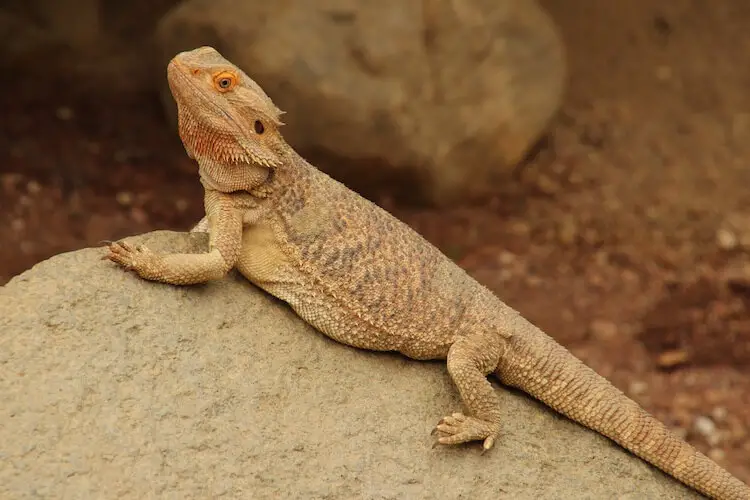
A large, semi-arboreal native lizard of Australia, bearded dragons spend their time dwelling partially in the trees and on the ground. Including their tail, they grow to about 15-20 inches long and have spines on either side of their body that run to the base of their tail.
Bearded dragons received their name due to the flap of skin under their chin which opens up to scare off predators.
The common name for Bearded Dragons refers to all 8 species of the genus Pogona. They used to be in the genus Amphibolurus grouping but have since been placed in Pogona.
The most popular species of the six is the Pogona vitticeps (a.k.a. a Central Bearded Dragon) which have proven to be friendlier and low-maintenance when compared to the other five.
There are three main reasons why bearded dragons are so popular amongst reptile owners:
- Bearded dragons are widely bred across the US, so consequently, there are many reputable breeders and are easily found
- They are very tolerant to handling and adapt very quickly to captivity
- Unlike other lizard species, bearded dragons aren’t nocturnal so are active during the day
Many today in the United States are descended from a handful of Dragons that were imported from Germany in 1980.
| Quick Facts | |
|---|---|
| Common Names | Eastern, Black-Soil Plains, Lawson’s, Rankin’s, Kimberly, Small-Scale, Western, Dwarf, North-West, Nullarbor, Central and Inland Bearded Dragons (all depending on species) |
| Scientific Name | Pogona barbata, P. henrylawsoni, P. microlepidota, P. minor, P. nullarbor, P. vitticeps |
| Adult Size | 15 to 20 inches, 230 to 520 grams |
| Lifespan | 7-12 years |
| Diet | Leafy vegetables and insects |
| Tank Size | 4ft x 2ft x 2ft at minimum |
| Humidity & Temperature | UVB and infrared lights, 30%-40% humidity, 95℉-105℉ basking area, 80℉ during the day |
| Popular Alternatives | Leopard Gecko, Crested Gecko and Blue-Tongued Skinks |
Bearded Dragon Care Sheet
The following care guide is based on the Pogona vitticeps Bearded Dragon and the advice may vary slightly depending on which of the six species you adopt. However, most of our advice below will be fine for all six species.
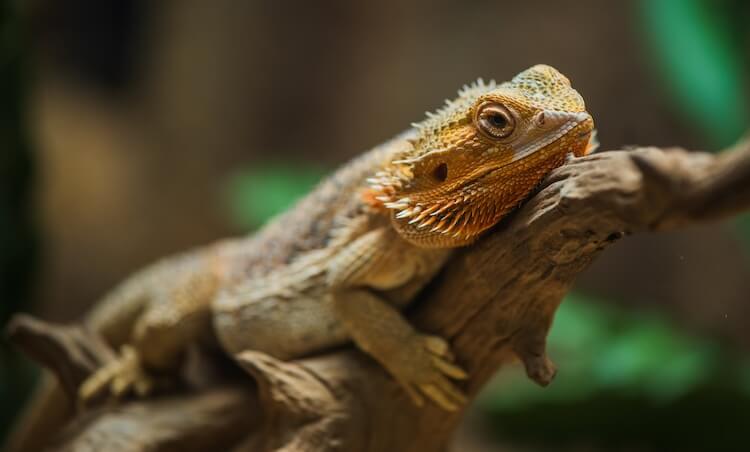
The wild habitat of this lizard consists of a forested, semi-desert environment in Australia. Bearded dragons are semi-arboreal and like to spend their time up on branches or on the ground.
They have relatively easy care requirements; they need:
- A UVB lamp and an infrared lamp for heat
- A mixed diet of insects and leafy vegetables
- A glass cage measuring 36ft³
Tank and Enclosure
The enclosure of a Bearded Dragon should be glass with a screen top. Their tank should measure anywhere from four to six feet long, two feet wide, and two to three feet high.
A tank of this size is big enough for this lizard and it will also help the tank from overheating. In general, the bigger the tank the better.
To better replicate their natural environment, there should be rocks and branches in the tank to give them places to hide and shade to cool off after spending time in warm lights.
Lighting and Heating
A diurnal lizard, bearded dragons are awake and active during the daytime. They should get 12 hours of daylight and 12 hours of darkness.
Bearded Dragons require an ultraviolet light to be fully healthy (and when combined with calcium supplements helps to prevent Nutritional Secondary Hyperparathyroidism and Metabolic Bone Disease). UVB bulbs can be monitored with a UV radiometer and should be replaced every 6-12 months. In addition to a UVB bulb, they should also be provided with a 40 to 75W infrared bulb to bask in.
Some enjoy being outside in natural daylight, if you do decide to do this, make sure to supervise your dragon at all times!
There should be distinct climates in the tank: a basking side and a “cool” side. You should keep two thermometers to monitor the temperatures of both sides:
- Bearded dragons enjoy basking in the heat and this section of your tank should be 95℉-105℉
- The rest of the tank should be about 80℉ during the day, but this may reduce at night. Using heating pads underneath the tank will prevent any rocks in the tank from getting too hot
When basking in heat, their ribs will expand to maximize the amount of heat they absorb and this gives them a “flat” appearance
A Bearded Dragon opening its mouth and “smiling” excessively may indicate that the tank is too hot.
The humidity in the tank should stay between 30%-40%, and this can be maintained by misting the tank every 48 hours. The exact humidity and temperature depend on the geographical location and ultimately the species of Bearded Dragon you have in captivity. In general, temperatures are very high and the humidity is relatively low.
Substrate
It is possible to use sand or gravel for a more authentic substrate. However, sand can have a detrimental effect on your dragon’s gastrointestinal tract if bearded dragons accidentally consume it.
Newspapers and paper towels are safer options and are also much easier to clean and dispose of. This substrate should be cleaned regularly or if it shows any signs of bacterial growth.
| Tank Tips | |
|---|---|
| Tank Type | Glass tank with screen top |
| Lighting | UVB and infrared |
| Best Substrate | Newspaper |
What Does A Bearded Dragon Eat?
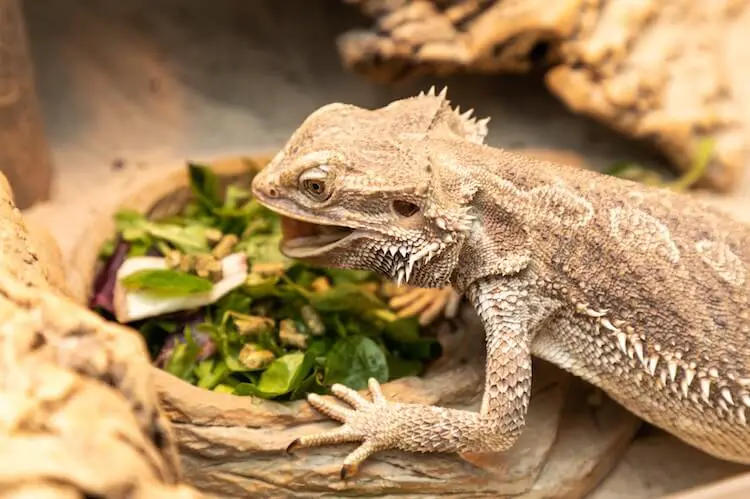
In the wild, they are omnivores. Bearded dragons eat spiders, insects, worms, small rodents, smaller lizards, greens, fruits and flowers.
They are an opportunistic predator that attacks their food when it is close by.
When in captivity their diet is easy to maintain.
As a hatchling (less than 2 months old), they will eat 2-3 times a day.
This diet should consist of 30% vegetables and 70% small crickets. The protein in a dragon’s diet can consist of crickets, superworms, or even a pinky mouse. In all life-stages, they should eat the following vegetables:
| Vegetables You Can Feed A Bearded Dragon | ||
|---|---|---|
| Dandelions | Romaine lettuce | Beet tops |
| Leafy greens | Carrots | Squash |
| Zucchini | ||
As juveniles, young bearded dragons should eat every day and have a balanced diet of leafy greens and insects. Feed your pets greens every day and insects every other day.
In their adult stage, a Bearded Dragon should be fed daily. This should consist of mostly crickets and lots of green vegetables like collard greens and mustard greens.
Calcium and Vitamin D3 supplements should also be incorporated into their food to keep them healthy. The best time of day to feed your dragon is the morning as this allows them to digest their food in the warmest part of the day.
In terms of hydration, they are picky if they have to get their water intake from a deep bowl. Therefore, it is best to offer them water from a shallow water bowl with clean water at all times.
| Diet Summary | |
|---|---|
| Insects | Crickets and mealworms fed several times per week |
| Fruits | 0% |
| Vegetables | Leafy greens, carrots, squash, zucchini |
| Supplements Required | Calcium and Vitamin D3 |
How To Keep Them Healthy
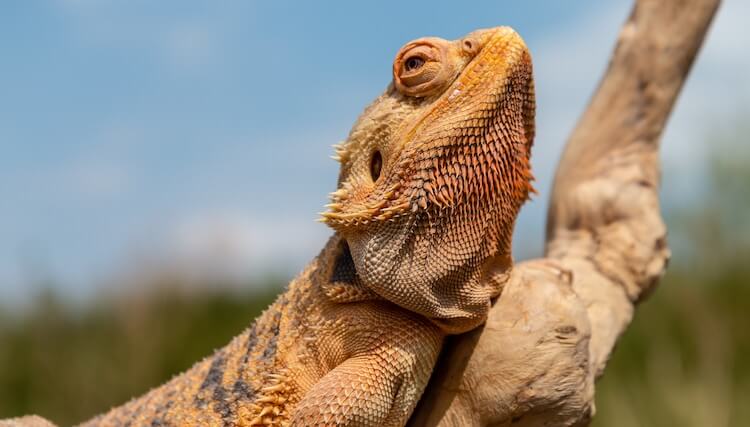
One of the best ways to keep your Bearded Dragon healthy is consistent and correct husbandry!
Bathing your dragon is not an absolute requirement, but soaking them in lukewarm water 2-3 times per week will help them defecate. When they shed, they do so in several pieces over a couple of days. Frequency of shedding depends on diet and time of year.
They are likely to shed their skin in the spring and summer when they eat regularly. Any abnormal shedding may occur near the digits and tip of their tail. When this happens, they may need to be bathed to avoid any infection.
Cleaning Their Tank
When cleaning their tank, you should fully remove and replace the substrate each week. Newspaper and paper towels are far easier to replace than sand.
The tank should be cleaned fortnightly with dilute soap and water.
If there is old food, feces, or spilled water on the substrate, spot clean this daily. When checking and cleaning out your dragon’s waste, you should look for any abnormalities. A Bearded Dragon’s normal feces should be brown and pelleted, and there should also be a semisolid urate.
If the waste looks abnormal or if you see blood, this could be a sign of an endoparasitic infection and you should bring your dragon to the vet.
How Long Do Bearded Dragons Live For?
Beardies live for between 7 and 12 years in captivity. They are relatively healthy pets and most bearded dragons will only experience health issues that arise from improper husbandry.
A calcium deficiency, or an excess of phosphorus, in their diet, or lack of a UVB light source, could lead to metabolic bone disease (also called nutritional secondary hyperparathyroidism). An indication of this disease is your dragon is dragging its legs, tail, or body instead of standing up strongly.
Trauma due to cage aggression can also occur in dragons that are being housed together. Intestinal impaction (common from eating substrate), and renal and cardiac diseases are less common in this species.
| Signs They Are Healthy | Sickness Symptoms |
|---|---|
| Happy to bask | Vocalizing distress |
| Will alternate between going to the basking area and the shade | Only spending time in the basking area |
| Will run away when you try to catch them | Random weight loss |
| Muscles are well-rounded and Dragon stands high and tall on all four limbs | Refusing to eat |
Bearded Dragon Behavior
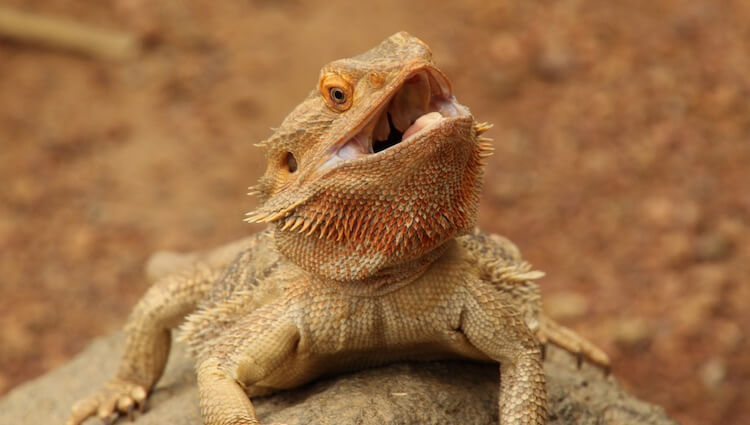
While in the wild in their natural habitat, this species of Lizard tends to be aggressive towards one another. If several live in the same area, they will create a social structure with one dominant lizard. They may fight, chase, or even ride each other. The dominant lizard will be the most social one of the groups and will often challenge others.
Bearded Dragons will challenge each other for food. They do this by bobbing their heads and turning their legs in circles, a pattern called circumduction. They will also stare at each other with intense gazes.
When they feel threatened, either by a dominant dragon or by a predator, its “beard” will extend to make them appear threatening and much bigger.
In captivity, Beardies may show similar behavior if housed with other dragons, Although they are very friendly with humans, it is best not to house these reptiles together, as they will form a social hierarchy and potentially become aggressive.
Alone, Bearded Dragons are happy and friendly lizards. They will occasionally hide, but are content to frequently change back and forth between their basking spot and shade.
It is possible for Bearded Dragons to go through a brumation period where they eat slightly less regularly and sleep for two weeks to four months. Many breeders will send their dragons through brumation before sexing. This can be achieved by keeping the tank at 60℉-75℉ for 4-6 weeks and gradually increasing the temperature with time.
Handling
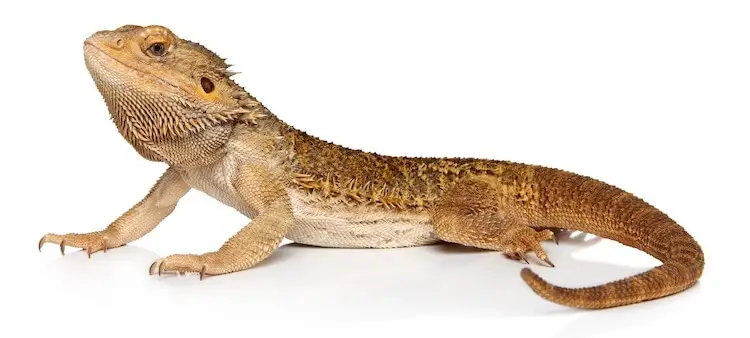
Always be sure to wash your hands before and after handling your dragon. This helps prevent the spread of most bacteria such as Salmonella. Beardies are very docile towards people.
Although they may run away when you try to grab them initially, they tolerate handling very well and may even be content to hang out on your shoulder.
If you hold them flat (instead of cradling them) they will feel safer. When you get a new dragon, give them three to four days to adjust before attempting to handle for short periods of time.
Appearance
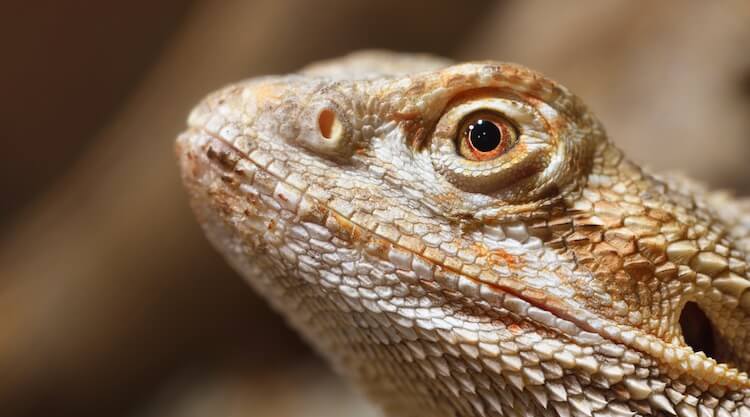
Beardies have round pupils, fleshy tongues, and lateral spines that travel down their sides to the base of their tail.
Their heads are large and broad and have a triangular shape. They also have “beards” that distend and serve as a defense mechanism when they feel threatened. In addition, head bobbing can be a sign that your pet is feeling threatened, uneasy, or uncomfortable.
Male bearded dragons tend to have deeper coloration and more distinct markings than female bearded dragons. They also tend to have a wider tail base.
Size
A Bearded Dragon is between 15 to 20 inches long. This may sound big to beginner herpetologists, however, without their tail, their snout to vent size is only 10 inches! An adult will be between 230g and 520g and should reach this weight within 18-24 months.
Colors
They vary from brown to orange depending on the species and morph. Sandfire morphs are closer to a red color, while pastel lizards have a silute pigmentation. Some are also known to come in yellow.
There are a couple of specific bloodlines which are bred in captivity for a specific appearance:
- The Leatherback is bred for a reduced scale size
- The Silkback is bred to have no scales
Bearded Dragon Babies
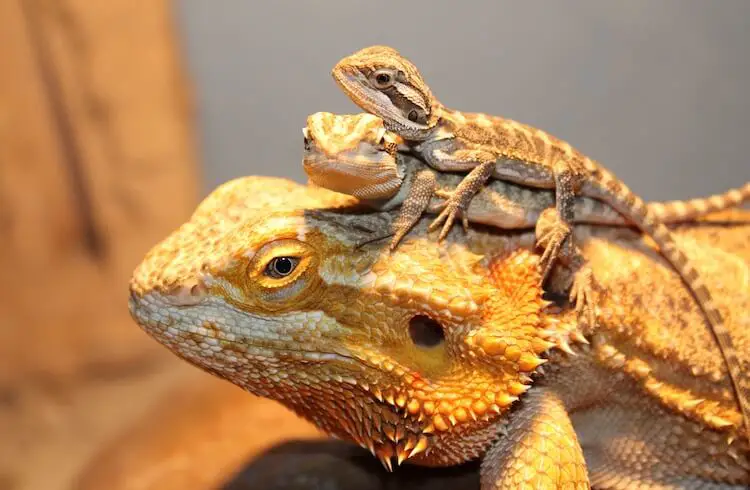
When a male bearded dragon wants to court a female, he will darken his throat and circulate around her. If she accepts, she will flatten her body to allow copulation. During copulation, the male will bite the neck of a female. This mating occurs in spring and early summer when progesterone levels in the female are high. This is after brumation, so it is ideal to brumate your reptiles before breeding them.
A nest box must be provided for the pet Bearded Dragons, as they bury their eggs., an area that contains 10-inch deep sand or soil should suffice. Unlike most reptiles, female bearded dragons will lay three clutches of up to 35 eggs per clutch.
After the female lays the eggs, they should be removed from the nest box and put in an incubator that contains water and vermiculite soil replacer at 82℉-86℉ and they will hatch in 3-4 weeks.
Newborns have an egg tooth that they use to pick their way out of their shells. After they hatch, dragons should be removed from each other immediately, as they can develop a social hierarchy much like they do as adults.
A beginner herpetologist, if looking to purchase Beardies (instead of breeding), should look to buy their reptile at 3-6 months of age. By this time, they are growing and eating regularly.
How Much Does A Bearded Dragon Cost?
Baby Bearded Dragons can cost $30-$60, but and juveniles around six months of age can cost as much as $100 USD.
Care Guide Summary
| Pros | Cons |
|---|---|
| Docile behavior | Extra heat and lighting required |
| Friendly personality | Cannot be housed together |
| Adaptable to captivity |
The friendly Bearded Dragon is a great reptile for those who are beginners. They are relatively easy to care for, and their docile temperaments make them easy to handle. They are also beloved for their “smiling” faces and unique personalities.
There are few reptiles that may be able to compete for a spot in the hearts of reptile owners as well as this Dragon. The Leopard Gecko is also a great beginning reptile.
Some lizards that are more of a challenge to handle include the Crested Gecko or Blue Tongued Skink. These animals are not quite as outgoing as a Bearded Dragon, but they do not require as much heat or lighting as the dragon.
All in all, Beardies are an easy-going reptile that eats an accessible diet. They do have heating and lighting requirements, but these are easily attainable with the correct setup.
Choose one that you want to bring home, and make it part of your family!

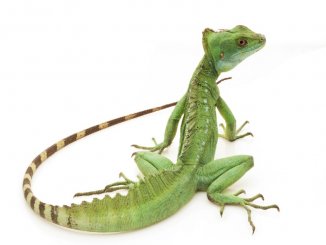
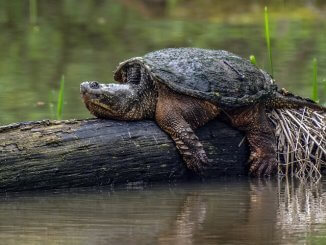
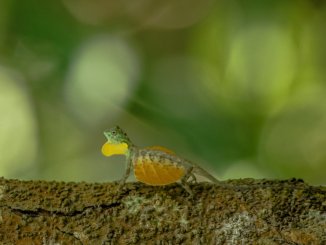

I have a citrus bearded boy. He is 5 yrs old and I have had him from 8 weeks old. He is 17 inches long and loves cuddles.
I am picking up my first ever bearded dragon next week! I hope this helps me give it the longest and healthiest life possible! I can not wait!
How has it gone? I am thinking about getting one for my two kids, but want to have as much knowledge as possible before I go.
I bought my bearded dragon a month ago. I’m enjoying him tremendously.
How much do they usually eat per day and how long does it take them to start eating normally after you first bring them home?
Hi Melody, we cover this in detail in our Bearded Dragon Feeding Guide!
Can you recommend organizations/businesses to buy a bearded dragon? I’ve read that box pet stores aren’t the greatest. Is this true? Our older son has been asking for one, but I don’t know the reliable places to get one. Thank you.
Hi Terra, next week we are publishing our guide to bearded dragon breeders, so keep an eye on the website!
I know at Petsmart you can adopt one if it can’t be sold. My husband works there and they can get tail rot from shipping, and even if it’s completely cured and practically no damage was done they can’t sell them, but they do have to be treated and seen/released by a vet before given to the adoptee. Ours had tail rot, and only the very tip of its tail was damaged (so little you can’t even tell).
I am new to bearded dragons
I was given two from a friend
The last pop had undigested wax worms.
My wife and I take them out each bay after I come home from work.
We give them 10 wax worms each day
Are we feeding them too many?
I give them kail spinach and variety of
fruit and vegetables. Why was there undigested wax worms, and should we be concerned
Hi James,
Are you sure they are whole worms and not a partially digested shell? Also, are both Beardies doing this? Finally, how long do they bask for after eating?
I hope you’re not keeping them together in one enclosure. Eventually one will kill the other. They need to be kept separately.
Not sure about it the other stuff, but I’ve been warned not to give spinach. It can be deadly to them.
Are heated rocks good for bearded dragons? Is there any brand or feature which in particular is good? This would be for a full grown lizard.
Heated rocks can burn the belly of the bearded dragon because they will not move off it even if it hurts, according to my vet. If you must have a heated rock, be sure to only have it on for just a few minutes everyday at a low temperature.
Wring types can get to hot and burn the breaded dragons belly
I’m looking for a red bearded dragon not a baby but not a adult. How much?
My gf has a young bearded dragon and we have had him for a month and everything was great but now he running away from us when we try to feed him or even try to pet him. He also does the flair up and like acting like he is hissing.
i rescued a bearded dragon that wasn’t fully mistreated just wasn’t taken care of on time but I cant get her to poop I’ve tried many things its been almost two weeks not sure what I could do she eats like no problem but I’m not sure if that’s normal or not any help would be appreciated
Could you have missed it? This should certainly happen more often, but unless you follow her every movement, you might have not noticed it happen.
If she was brumating in her previous home, it is normal to take some time to re-adapt her body to her normal self.
I have had a bearded dragon for 2 months. The last couple of days he does not want to be held. He just shedded yesterday, could that be it? Suggestions or is it just a mood thing. I am still learning about them.
That would be my guess, yes! Shedding is a delicate process that can cause some stress in the lizard. It is when they are most vulnerable, so being held is perhaps a bit of an unsettling feeling. In terms of handling I would suggest you wait till the end of the shedding process and then attempt to touch the animal little by little and not during feeding time.
My mom got one but it has become grayish is that a problem or no?
“It could be. But you need to understand exaclty what is happening among these 3 possibilities:
When shedding begins, sometimes the first visible sign is a whitening or greying of the outer skin, as it starts detaching from the body. Usually the dragon is lighter in color than it was previously.
Another reason could be that the dragon is cold! and it turns greyish in an attempt to absorb more solar radiation. The dragon is darker in color than it was previously.
And finally, your dragon might be turning slightly grey simply because he is getting old, although this change should not be as drastic as the other two. “
My bididragen is about 7years old he doesn’t chase his food eny more and iv noticed that his head some times shake s
It is important to distinguish between two similar behaviors: head bobbing and head shaking. If he is bobbing his head once or twice per second, with large up and down movements of the neck, this is a normal behavioral trait implicated in asserting dominance and in mating.
However, if your dragon is truly shaking his head in tiny movements many times a second, this could be cause of concern. Most likely, he is calcium-deficient and the most common reason for this is an inadequate exposure to UVB light.
Reptiles need UVB light to process the calcium they intake from their diets. If your UVB bulb is too weak, too far, or simply too old to provide the stated amount of UVB light, your dragon will experience calcium deficiency which can be quite serious. (Keep in mind some bulbs need to be changed on a monthly basis! and most of them do not last longer than 6 months).
Our advice would be to change the UVB bulb and perhaps add some calcium supplements to his diet once every few meals.
I bought my bearded month ago or so I believe that she does not like me she get in her defensive state what could I do to change that?
This is not uncommon. There are a couple of things to keep in mind to solve this. Movements and eyes: do not move fast, be gentle in your movement and do not make excessive eye contact. Sit around his enclosure where he can see you, and then just chill there! He will eventually understand you’re not there to hurt him.
Food: when you feed him, make sure you limit the interaction to feeding. Do not feed him, and handle him or clean his enclosure. Different actions should be done at different times, to sort of get him into an expectable schedule. Handling should be a progressive experience, one in which you gain each others trust step by step. Do not disrupt his sleep, and try to recreate his natural cycle of day and night. Last but not least, keep an eye out for good and bad signals, when they’re relaxed Bearded Dragons can be very playful animals: you will notice when he’s getting more relaxed and when he’s getting tense, so act in response to these signals. Anyway, most of the times it is just a matter of time, but these things can go a long way making the transition quicker. Hope this helps!
We live in San Francisco and cannot get the room humidity below 50%. Is there a tank mounted dehumidifier that we can use?
Yes they certainly exist. I have never used them but have heard good things about Lockdown and Pro Breeze dehumidifiers.